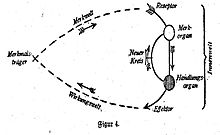Umwelt



In thesemiotic theoriesofJakob von UexküllandThomas Sebeok,umwelt(plural: umwelten; from the GermanUmweltmeaning "environment" or "surroundings" ) is the "biological foundations that lie at the very center of the study of bothcommunicationandsignificationin the human [and non-human] animal ".[1][failed verification]The term is usually translated as "self-centered world".[2]Uexküll theorised that organisms can have differentumwelten,even though they share the same environment. The termumwelt,together with companion termsUmgebung(an Umwelt as seen by another observer) andInnenwelt(the mapping of the self to the world of objects),[3]have special relevance for cognitive philosophers, roboticists and cyberneticians because they offer a potential solution to the conundrum of theinfinite regressof theCartesian Theater.
Discussion[edit]
Each functional component of anumwelthas ameaningthat represents the organism'smodelof the world. These functional components correspond approximately to perceptual features,[4]as described byAnne Treisman.It is also thesemioticworld of the organism, including all the meaningful aspects of the world for any particular organism. It can be water, food, shelter, potential threats or points of reference for navigation. An organism creates and reshapes its ownumweltwhen it interacts with the world. This is termed a 'functional circle'. Theumwelttheory states that the mind and the world are inseparable because it is the mind that interprets the world for the organism. Because of the individuality and uniqueness of the history of every single organism, theumweltenof different organisms differ. When twoumwelteninteract, this creates asemiosphere.[5][6]
As a term,umweltalso unites all the semiotic processes of an organism into a whole. Internally, an organism is the sum of its parts operating in functional circles and, to survive, all the parts must work cooperatively. This is termed the "collectiveumwelt"which models the organism as a centralised system from the cellular level upward. This requires thesemiosisof any one part to be continuously connected to any other semiosis operating within the same organism. If anything disrupts this process, the organism will not operate efficiently.
Uexküll's writings show a specific interest in the various worlds that he believed to exist ('conceptually') from the point of view of theumweltof different creatures such asticks,sea urchins,amoebae,jellyfish,andsea worms.
Thebiosemioticturn in Jakob von Uexküll's analysis occurs in his discussion of the animal's relationship with its environment. Theumweltis for him an environment-world which is, according toAgamben,"constituted by a more or less broad series of elements [called] 'carriers of significance' or 'marks' which are the only things that interest the animal".Agamben goes on to paraphrase Uexküll's example of the tick, saying:
"...this eyeless animal finds the way to her watchpoint [at the top of a tall blade of grass] with the help of only its skin’s general sensitivity to light. The approach of her prey becomes apparent to this blind and deaf bandit only through her sense of smell. The odor of butyric acid, which emanates from the sebaceous follicles of all mammals, works on the tick as a signal that causes her to abandon her post (on top of the blade of grass/bush) and fall blindly downward toward her prey. If she is fortunate enough to fall on something warm (which she perceives by means of an organ sensible to a precise temperature) then she has attained her prey, the warm-blooded animal, and thereafter needs only the help of her sense of touch to find the least hairy spot possible and embed herself up to her head in the cutaneous tissue of her prey. She can now slowly suck up a stream of warm blood."[7]
Thus, for the tick, theumweltis reduced to only three (biosemiotic) carriers of significance: (1) theodorofbutyric acid,which emanates from thesebaceousfollicles of all mammals; (2) thetemperatureof 37°C (corresponding to thebloodof all mammals); and (3) the hairy topography of mammals.
Critics[edit]
Uexküll's application of the notion of "umwelt" to the human person has been contested. In "Welt und Umwelt"[8]and "Die Wahrheit der Dinge", the philosopher and sociologistJosef Pieperargued that reason allows the human person to live in "Welt" (world) while plants and animals do indeed live in an Umwelt—a notion he traces back far beyond Uexküll toPlato,Aristotle,andThomas Aquinas.
See also[edit]
- Cognized environment– Anthropological concept
- Existential therapy– Form of psychotherapy
- Phenomenology– Philosophical method and schools of philosophy
- Qualia– Instances of subjective experience
- Reality tunnel– Theory of personal perception
- Worldview,also known as Weltanschauung – Fundamental cognitive orientation of an individual or society
References[edit]
- ^Sebeok, Thomas A. (1976). "Foreword".Contributions to the Doctrine of Signs.Lisse, Netherlands: Peter de Ridder Press. p. x.ISBN0-87750-194-7.
- ^Kull, Kalevi(2010). "Umwelt". In Cobley, Paul (ed.).The Routledge Companion to Semiotics.London: Routledge. pp. 348–349.ISBN978-0-415-44072-1.
- ^Cobley, Paul (2010).The Routledge Companion to Semiotics.London and New York: Routledge. p. 348.
- ^Treisman, Anne M.; Gelade, Garry (1980). "A feature-integration theory of attention".Cognitive Psychology.12(1): 97–136.doi:10.1016/0010-0285(80)90005-5.PMID7351125.S2CID353246.
- ^Uexküll, Thure von (1987). "The sign theory of Jakob von Uexküll". In Krampen; et al. (eds.).Classics of Semiotics.New York: Plenum. pp. 147–179.ISBN0-306-42321-9.
- ^Uexküll, Jakob von (1957). "A Stroll Through the Worlds of Animals and Men: A Picture Book of Invisible Worlds". In Schiller, Claire H. (ed.).Instinctive Behavior: The Development of a Modern Concept.New York: International Universities Press. pp.5–.
- ^Agamben, Giorgio,The Open: Man and Animal(PDF),p. 46,S2CID141790408,archived fromthe original(PDF)on 2019-10-25
- ^Joseph Piepers, “Welt und Umwelt,” in Schriften zur Philosophischen Anthropologie und Ethik: Grundstrukturen menschlicher Existenz, 180–206.
Further reading[edit]
- Kull, Kalevi (1998)."On Semiosis, Umwelt, and Semiosphere".Semiotica.120(3/4): 299–310.
- Naming Natureby Carol Kaesuk Yoon
- Augustin, Prisca (2009)."Translating Jakob von Uexküll — Reframing Umweltlehre as biosemiotics".Sign Systems Studies.37(1/2): 281–298.doi:10.12697/SSS.2009.37.1-2.10.
- View from the Oakby Herbert and Judith Kohl The New Press |https://thenewpress /books/view-from-oak
- Inside of a Dog: What Dogs See, Smell, and Knowby Alexandra Horowitz Scribner |https:// simonandschuster /books/Inside-of-a-Dog/Alexandra-Horowitz/9781416583431
- An Immense Worldby Ed Yong Penguin books Vintage |https:// penguin.co.uk/books/440513/an-immense-world-by-yong-ed/9781847926081
External links[edit]
- UmweltbyJohn Deely
- Umwelt and Phenomenology
- Umwelt and semiospherebyKalevi Kull
- Pragmatism and Umwelt-theoryby Alexei Sharov
- TDE-R - A Subjective Biocomputerby Charles Dyer
